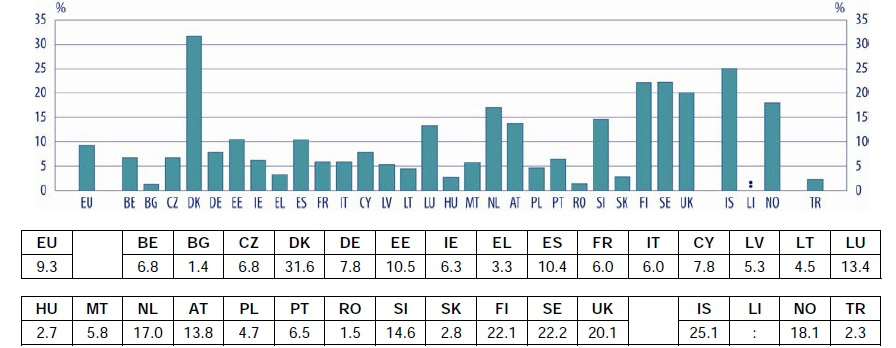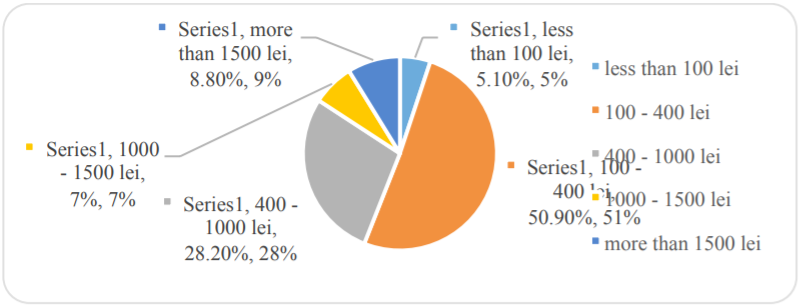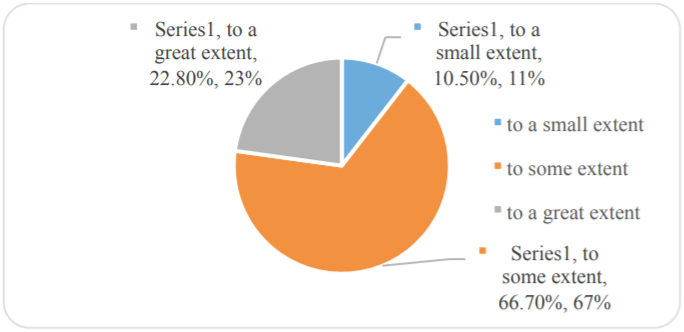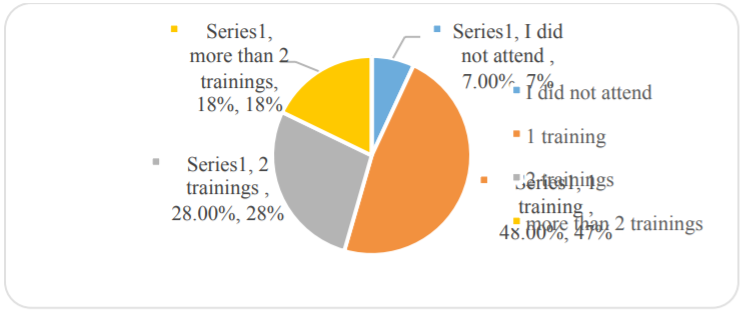Abstract
This paper aims to highlight some aspects of adult education in Romania, the institutions responsible for adult training and the current trends in this field, focusing on training needs and options’ analysis of adult learners. The idea of this study came in sight as a result of our interests in this area and due to the changes that have occurred at national and European level in adults training. We deemed appropriate to use a quantitative research method for gathering the information (questionnaire-based survey). The survey included over 100 adult respondents, aged between 18 and 60 years. More specifically this study was designed to explore the following questions: What is the opinion of adults regarding training courses offer on the market? What factors affect the choice of a training course for adults? What are the ways and degree of access to information about training courses for adults? What are the main training fields covered by the training providers in Romania? By conclusions and recommendations from the research conducted, we intend to shape a real picture of the trend regarding the degree of access to adults’ courses in Romania.
Keywords: Adult educationtraining courses offertraining fieldstraining providersdegree of access to adult training
Introduction
Education, being a complex activity, begins in infancy and continues throughout one’s life. Ever
since the seventeenth century Czech teacher Comenius Jan Amos stated: "Tota schola vita est" (all life is
school).
Europe is experiencing major transformation in which knowledge and innovation are the most
valued assets. […] So much the more this need is stressed in adult and continuing education from the
perspective of the stringent upskilling demand of Europe’s labour force (Sava, S., Lupou R., 2009).
expansion of the educational offer is meant to compensate for inadequate initial education; to complete
general knowledge. In a purely temporal sense, adult education includes continuous training, recurrent
education, compensatory education (or "second chance"), literacy, education during leisure time ("leisure
education") (Romanian Government, 2000).
Problem Statement
The concept of "Andragogy", explained as the science and practice of adult education was
introduced in scientific circles in 1883 by Alexander Kapp, and it was developed into a theory about adult
education by American educator Malcolm Knowles. In 1919, in England, the Committee for adult
education launched the idea of lifelong learning, and in 1929 a paper was published with the same title. It
should be noted that the idea of lifelong learning appeared, perhaps not by accident, in the adult education
system.
Regardless of the terminology adopted – "general knowledge, permanent education, recurrent
education, popular education, voluntary education, adult education, continuing education, accelerated
professional education, adult training, adult pedagogy, adult sociopedagogy, andragogy etc." – (Jinga, I.,
Istrate, E., 2001, p. 163) it is generally acknowledged that adults engaged in training/learning activities
have characteristics and specific needs which differentiates them from students, who are traditionally the
subject of the educational process. Adult education is carried out in three distinct areas: attitudes, skills
and knowledge. Each area is important in order to achieve good performance in work. A prerequisite for
maintaining flexibility in profession is continuous training. In the common sense, training is considered
complete when a skill is certified with a document; in fact, it is just a proof of basic skills (necessary but
not sufficient) and a platform for building a complex professional route later (Jigău, 2003, p. 79).
In the last decade, adult learning took center stage in the European policies for cooperation in
education and training. Thus, chief ministers of the Department for Education in all member states of the
European Union agreed that by 2020 at least 15% of adults should participate in some form of education
or training, due to the key contribution of adult education to competitiveness, job market and social
adaptability.
At European level, three surveys provide data enabling evaluation of adult participation in
education and training: Labour Force Survey of the EU (EU LFS), the Adult Education Survey (AES) and
the Continuing Vocational Training Survey (CVTS) (Education, Audiovisual and Culture Executive
Agency, 2011, p. 10). Adult participation in lifelong learning is far from reaching the agreed reference
level of 15% in most EU states; only Denmark, the Netherlands, Finland, Sweden and the UK have
exceeded this target. The percentage varies significantly from 1.4% to 31.6% (2012). In Romania and
Bulgaria adult participation in education and training lags far behind EU indicators - less than 2% of
adults are involved in educational and training programs). The same can be said about Greece, Hungary,
Slovakia and Turkey (where the percentage is below 4%, as it can be seen in the figure below)
(Education, Audiovisual and Culture Executive Agency, 2011, p. 12).

Validation and recognition of informal and non-formal learning are necessary tools to motivate
adults to engage in learning throughout life. All EU member states, including Romania, have developed
or are currently developing National Qualifications Frameworks (NQF), in line with the European
Qualifications Framework (EQF). More than half of EU countries have taken measures addressing the
development of qualifications and quality assurance in education and training. According to the National
Qualifications Authority (NQA), one of the challenges Romania is presented with is increasing the
participation of adults (25-64) in lifelong learning to 10% by 2020. So far, Romania has made
considerable progress in that respect, considering that in the last 6 years (2007-2013) adult participation
in training programs grew only by 0.7 percent (2% currently). In the opinion of Sava (2008) the
Romanian society is still experiencing ongoing reform and transformation, which is in turn affecting the
whole of society as well, from the economic, cultural, social, and political point of view. The magnitude
of these changes is producing many personal, social, and economic crises.
As claimed by some statistics, our country has one of the lowest rates of adult participation in
lifelong learning, recording progress under the minimum standard set by the European Commission. EU
Strategy 2020 sets the achievement of a 15% to adults participating in lifelong learning. Nationwide there
are a series of educational programs for adults; most of these programs are financed by European funds ȋn
the Sectoral Operational Programme Human Resources Development 2007 - 2013, Priority 1: Education
and training in support of growth and development of knowledge based society. With regard to
educational programs conducted in Romania, the European Commission had a significant intervention
through the "learning throughout life" - "Lifelong Learning Programme".
In Romania, the National Qualifications Authority, the Ministry of Education and Ministry of
Labour are the main institutions that manage the authorization, accreditation and certification of adult
training. The minimum duration of the qualification programs depends on the level of qualification. The
total duration of these programs, expressed in hours of training is as follows: 80-120 hours for the first
level of qualification; 360 hours for the second level of qualification; 720 hours for the third level of
qualification; 1080 hours for the fourth level.
Upon completion of the training activities, adult learners receive a certificate of professional
competence). Certificates are issued to persons who have completed vocational training in the following
categories: Initiation programs, improvement programs, specialization programs and common skills.
Training programs for adults are offered by training providers that can come from the public or
private sector. Training providers in the
Training, which analyze regional training needs and propose training programs (currently operates six
such centers); training centers for certain fields of activity with public funding (eg Romanian Aviation
Academy, the National Cinematography Center, Training Centre for Court Clerks, the National Institute
of Administration, etc.).
Private sector providers are represented by cultural associations and religious unions and
organizations belonging to trade unions, NGOs, political parties (by departments and foundations of
education), professional associations or employers (eg Romanian Banking Institute, the Romanian
Business School of the Chambers of Commerce and Industry of Romania, network training for public
administration in Romania).
These institutions offer specific training for specific fields of activity as well as several of courses
for the general public. Some of these institutions also have a role in setting quality standards in adult
training.
According to the National Qualifications Authority, in January 2015, the situation of authorized
training providers (who organized courses and in which were held graduation exams) was as follows: 28
companies, 13 public institutions and 25 NGOs and associations or foundations.
Research Questions
We believe that adult education can bring innovative solutions to problems of individuals and
society. Currently, adult education performs various functions, including: second chance to obtain a
qualification; fosters personal development; increases professional competence; helps adults to solve
important problems and to identify new ways to address them.
This study was designed to explore the following questions:
•What is the opinion of adults regarding training courses offer on the market?
•What factors affect the choice of a training course for adults?
•What are the ways and degree of access to information about training courses for adults?
•What are the main fields of training covered by the training providers in Romania?
Purpose of the Study
This paper aims to highlight some aspects of adult education in Romania, the institutions
responsible for adult training and the current trends in this field, focusing on training needs and options’
analysis of adult learners. More accurate, our research aims to highlight the current situation of adult
training in Romania from the perspective of their motivativation in attenting courses, choosing training
providers, and areas of interest.
Research Methods
The idea of this study cam in sight as a result of our interests in this area and due to the changes
that have occurred at national and European level in adults training. We deemed appropriate to use a
quantitative research method for gathering the information (questionnaire-based survey). The survey
included 114 adult respondents, aged between 18 and 60 years. Survey respondents are active adults in
the labor market, adults who participate in professional reconversion programs and students.
Considering that training providers on the market in Romania offers, broadly, training courses that
meet similar standards, this research will not refer to specific courses but rather wants to identify opinions
of adults about training courses, generally speaking.
Establishing Research Objectives:
The main objectives are:
•Identifying the profile of adults interested in vocational training courses; •Identifying the frequency of participation in vocational training courses by the people interviewed; •Identifying the training providers preferred by adults; •Identifying the availability to participate in vocational training courses; •Identifying the preferences of respondents on areas in which they have completed a training course
and areas where they want to work;
•Identifying the subjects opinion on training courses; •Identifying the extent to which media coverage of training courses by the providers influence the
choice of a training by respondents;
•Identifying the influence that the demands of the labour market have on choosing of a field of professional training.
Choosing of the Information Sources
Collection of information was done by survey method as a structured form of communication. All
subjects have been presented to the same questionnaire applied in the online environment.
Sampling, Choosing Sampling Methods, and Sample Size
The research was conducted online between 03.06.2016 - 12.06. 2016. The instrument used was
the questionnaire to which 114 people responded. The questionnaire was disseminated using online
platforms in virtual environments. Subjects responded to a total of 10 questions. Completion of the
questionnaire took an average of 7 minutes.
Findings
As mentioned previously, 114 adults responded to the questionnaire, the responses were
centralized, processed and represented in graphical form, as can be seen further.
First question that opens the series of 10 questions aimed at identifying the structure of the
questionnaire respondents by gender. We can see that 66.6% of respondents were female and the
remaining 33.3% are male. In terms of age groups, we can see that: 25.1% of respondents aged 18-25
years, 41.8% between 25-35 years and 7.8% over 35 years.
An important aspect of the research is to identify adults ‘awareness on the issues and needs
regarding continuous training. In this respect, when asking the question "To what extent are you familiar
with the issues and needs of continuous training?" we identified the following responses:
Following the answers given by respondents we computed the level of awareness, as follows: level
of awareness = (1*6+2*10+3*30+4*38+5*30)/114=3,66
We can see that a share of 33.3% of respondents are familiar with the issues and needs regarding
continuous training. There are some respondents, even if very few (5.3%) who are inadequately informed
about this topic.
All respondents are willing to pay for a training course, 50.9% of whom were willing to pay
between 100 and 400 lei, while 43% are willing to pay over 400 lei. We can see the availability of most
respondents about attending vocational training courses.

An interesting answer was obtained to the question "Do you think that your professional training
meets the current requirements of the labor market?. 66,7% respondents said that their professional
training corresponds to some extent with the demands of the labor market. So we can say that there is a
great need for continuous training, especially if we take into account the dynamics of competencies
required in the labor market.

The question regarding the number of vocational training courses attended highlighted the fact that
most respondents had participated in at least one training course, as can be seen in the graph below:

Regarding the choice of training providers, 71.9% of respondents prefer private providers at the
expense of the public because they believe that the level of professionalism and quality teaching materials
are superior in the case of the former. The fact that most respondents prefer to pay more to get high
quality training highlights the level of awareness regarding the importance of quality vocational training.
Centralizing answers to questions referring to the domains of training preferred by the respondents
has revealed that most of the respondents prefer courses in economics. The most interesting areas are:
trade - 35.1%, accounting - 15.8%, IT & C 14%, management 14%.
The main criterion in terms of choosing a course of training is the demands of the labor market
(over 80% of respondents).
Of all adults who were surveyed, 54.4% believe that continuing education programs are accessible,
in some measure due to the affordable participation fees. Insufficient promotion of training offers on the
one hand and the requirements in terms of professional training in the labor market, on the other hand, are
the main reasons for not attending training programs by adults.
An objective of this research was to identify the main criteria in terms of choosing a course of
training. Thus, 50% of respondents take into account the scientific quality of the course, 33.9% have as a
prime criterion for choosing the usefulness of the course, reflected in promotion at work, and the
remaining respondents take into account, first, the participation fee.
Conclusions and Discussions
We conducted this research with the intention of responding to four questions related to adults’
training in Romania. The first question was: What is the opinion of adults regarding training courses
with the issues and needs regarding continuous training and over 90% of respondents are willing to pay
for a training course. For the second question - What factors affect the choice of a training course for
of the labor market, the type of provider (71.9% of respondents prefer private providers at the expense of
the public ones), and the affordable participation fee (of all adults who were surveyed, 54.4% believe that
continuing education programs are accessible, in some measure due to the affordable participation fees).
Regarding the third question - What are the ways and degree of access to information about training
adults are the media and the Internet. The majority of the respondents choose the second option to get
information about courses for adults, mainly because of fast access, but also because they can focus on
specific search fields using search filters. The last research question referred to
economics (the most interesting areas are: trade, accounting, IT & C, and management)
As recommendations, we believe that it should be paid more attention to promoting training
courses so that adults could find out about them more easily and also, training courses should be more
closely linked to labor market needs.
References
- Jigău, M. (Ed.) (2003). Consilierea carierei adulților. Bucharest: ISE.
- Jinga, I., Istrate, E. (2001). Manual de Pedagogie. Bucuresti: All.
- Sava, S., Lupou R. (2009). The adult educator in Europe – professionalization challenges and the alternative of validation of learning outcomes. Procedia-Social and Behavioral Sciences 1 (1), 2227-2232. Retrieved from http://ac.els-cdn.com/S1877042809003954/1-s2.0-S1877042809003954-main.pdf?_tid=ba538680-0fac-11e7-9224-00000aacb360&acdnat=1490262199_fe696a53cac96fa21c4856afdf4a1a0a
- Sava, S. (2008). Trends in Adult and Continuing Education in Romania, a country in transformation. REPORT–Zeitschrift für Weiterbildungsforschung 31 (2), 28-38. Retrieved from https://www.diebonn.de/doks/sava0801.pdf.
- National Qualifications Authority. (2015). Instrucțiuni de întocmire și prezentare a documentelor de către furnizorul de formare profesională în vederea autorizării. Bucharest. Retrieved from http://www.anc.edu.ro/uploads/instructiuni%20de%20intocmire%20si%20prezentare%20a%20do cumentatiei.pdf.
- Education, Audiovisual and Culture Executive Agency. (EACEA P9 Eurydice). (2011). Educația formală pentru adulți: politici și uzanțe în Europa. Brussels. Retrieved at http://eacea.ec.europa.eu/education/eurydice/documents/thematic_reports/128RO.pdf.
- Romanian Government (2000). The order of the government no. 129/ 2000 regarding adults’ professional training. Retrieved from http://www.anc.edu.ro/uploads/images/Legislatie/OG%20129-2000republic%20febr%202014.pdf.
Copyright information

This work is licensed under a Creative Commons Attribution-NonCommercial-NoDerivatives 4.0 International License.
About this article
Publication Date
25 May 2017
Article Doi
eBook ISBN
978-1-80296-022-8
Publisher
Future Academy
Volume
23
Print ISBN (optional)
-
Edition Number
1st Edition
Pages
1-2032
Subjects
Educational strategies, educational policy, organization of education, management of education, teacher, teacher training
Cite this article as:
Mihaila, A. R., & Paduraru, M. E. (2017). Adult Training In Romania - Critical Analysis. In E. Soare, & C. Langa (Eds.), Education Facing Contemporary World Issues, vol 23. European Proceedings of Social and Behavioural Sciences (pp. 1372-1379). Future Academy. https://doi.org/10.15405/epsbs.2017.05.02.168

